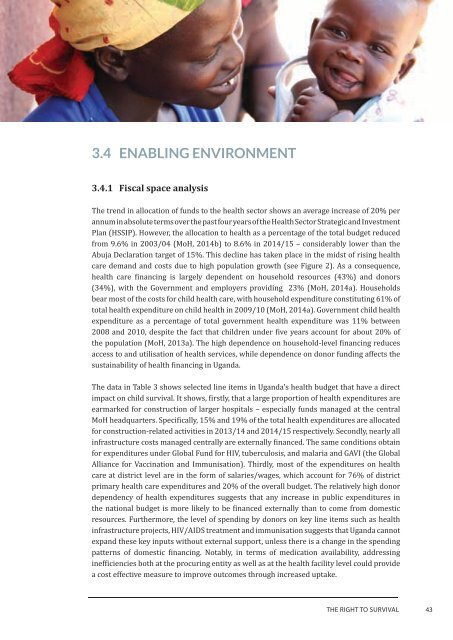Situation analySiS
1TNu802
1TNu802
Create successful ePaper yourself
Turn your PDF publications into a flip-book with our unique Google optimized e-Paper software.
<strong>Situation</strong> <strong>analySiS</strong> of Children in uganda 20153.4 ENABLING ENVIRONMENT3.4.1 Fiscal space analysisThe trend in allocation of funds to the health sector shows an average increase of 20% perannum in absolute terms over the past four years of the Health Sector Strategic and InvestmentPlan (HSSIP). However, the allocation to health as a percentage of the total budget reducedfrom 9.6% in 2003/04 (MoH, 2014b) to 8.6% in 2014/15 – considerably lower than theAbuja Declaration target of 15%. This decline has taken place in the midst of rising healthcare demand and costs due to high population growth (see Figure 2). As a consequence,health care financing is largely dependent on household resources (43%) and donors(34%), with the Government and employers providing 23% (MoH, 2014a). Householdsbear most of the costs for child health care, with household expenditure constituting 61% oftotal health expenditure on child health in 2009/10 (MoH, 2014a). Government child healthexpenditure as a percentage of total government health expenditure was 11% between2008 and 2010, despite the fact that children under five years account for about 20% ofthe population (MoH, 2013a). The high dependence on household-level financing reducesaccess to and utilisation of health services, while dependence on donor funding affects thesustainability of health financing in Uganda.The data in Table 3 shows selected line items in Uganda’s health budget that have a directimpact on child survival. It shows, firstly, that a large proportion of health expenditures areearmarked for construction of larger hospitals – especially funds managed at the centralMoH headquarters. Specifically, 15% and 19% of the total health expenditures are allocatedfor construction-related activities in 2013/14 and 2014/15 respectively. Secondly, nearly allinfrastructure costs managed centrally are externally financed. The same conditions obtainfor expenditures under Global Fund for HIV, tuberculosis, and malaria and GAVI (the GlobalAlliance for Vaccination and Immunisation). Thirdly, most of the expenditures on healthcare at district level are in the form of salaries/wages, which account for 76% of districtprimary health care expenditures and 20% of the overall budget. The relatively high donordependency of health expenditures suggests that any increase in public expenditures inthe national budget is more likely to be financed externally than to come from domesticresources. Furthermore, the level of spending by donors on key line items such as healthinfrastructure projects, HIV/AIDS treatment and immunisation suggests that Uganda cannotexpand these key inputs without external support, unless there is a change in the spendingpatterns of domestic financing. Notably, in terms of medication availability, addressinginefficiencies both at the procuring entity as well as at the health facility level could providea cost effective measure to improve outcomes through increased uptake.thE rIGht to SUrvIvaL43




